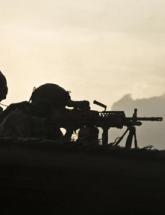 |
 |
The Haqqani Network

Executive Summary
Key Findings
The Haqqani network, which has the backing of elements within the Pakistani security establishment, is one of Afghanistan’s most experienced and sophisticated insurgent organizations.
- Although the Haqqani network is officially subsumed under the larger Taliban umbrella organization led by Mullah Omar and his Quetta Shura Taliban, the Haqqanis maintain distinct command and control, and lines of operations.
Siraj Haqqani, the son of the famous anti-Soviet fighter Jalaluddin Haqqani, is the current leader of the Haqqani network. Siraj is more extreme than his father and maintains closer ties to al-Qaeda and other foreign extremists in Pakistan.
- The Haqqani network maintains a safe haven in North Waziristan, Pakistan, across Afghanistan’s southeastern border. The Pakistani Army has consistently refused to launch a military operation in North Waziristan despite the presence of al-Qaeda senior leadership.
- Elements within the Pakistani security establishment continue to view the Haqqani network as a useful ally and proxy force to represent their interests in Afghanistan. To this end, Haqqani forces have repeatedly targeted Indian infrastructure and construction projects in Afghanistan.
Between 2002 and 2004, the Haqqani network reconstituted their operations in their historical stronghold of Loya-Paktia, which encompasses the provinces of Khost, Paktia and Paktika in southeastern Afghanistan.
The Haqqani network was able to expand beyond Loya-Paktia towards Kabul from 2005 to 2006, providing the network with the ability to execute attacks in the Afghan capital.
- From 2008 to 2009, the network launched an offensive aimed at strengthening their positions in Loya-Paktia, while projecting suicide bombers into Kabul to launch some the most lethal attacks of any insurgent group in Afghanistan.
- Until recently, U.S. and coalition troops lacked sufficient forces to reverse the momentum of the Haqqani network. The massive increase of special operations forces over the past year, combined with the increase in the number of conventional forces to execute counterinsurgency operations, is beginning to disrupt and degrade the Haqqani network’s infrastructure and operations.
- An increased drone campaign against senior Haqqani safe havens in North Waziristan has disrupted the network’s ability to plan and execute operations, and have targeted al-Qaeda senior leadership and other foreign terrorists.
Despite recent progress, Haqqani network operations can regenerate if not continually pressured. Therefore, efforts to neutralize the Haqqani network’s operation in Afghanistan require continuous and aggressive counterterrorism operations in Afghanistan and Pakistan in addition to sustained counterinsurgency operations in key populations in and around the Southeast.